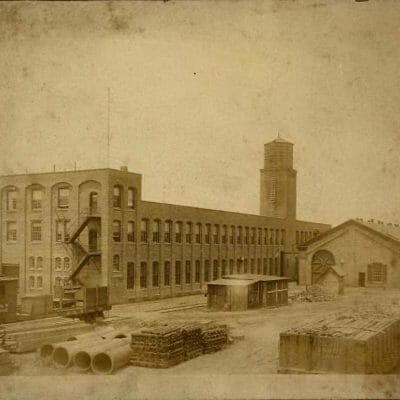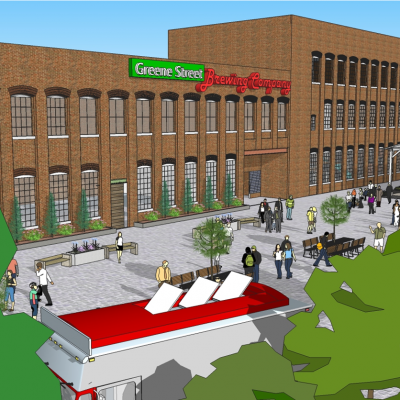EPA Brownfields Assessment Grant Status

United Cigarette Machine Company operated at 2501 Greene Street from 1907-1956. Photo courtesy of the Lynchburg Museum.
EPA and State Brownfields Grants to date: By evaluating abandoned, underutilized and deteriorating industrial and commercial sites, the City hopes to spur economic development and revitalization throughout the community. The Economic Development Authority applied for an EPA grant to provide the financial resources needed to continue the City’s transformation from a heavy manufacturing and industrial economy to a more diverse and dynamic economic climate. This project presents an opportunity to increase both residential and commercial property values.
- $400,000 Grant awarded September 2015
- $300,000 Grant awarded September 2018
- $50,000 Grant awarded August 2020
- $183,389 State Grants (4 Total)
For more information, please contact:
Marjette Upshur, Director of Economic Development
Phone: 434.455.4492
Email: marjette.upshur@lynchburgva.gov
What properties have been addressed to date?
- Former White Star Steam Laundry & Mid State Electrical SupplyChurch & 12th Streets
- Former Waytec Electronics Site, McConville Road
- Former Gould Batteries Site, Carroll Avenue
- Former United Cigarette Machine Co., Greene Street
- Former Bulk Fuel Storage Facility, Langhorne Road
- Former Piedmont Express/Trucking Facility, Murray Place
- Lynchburg Grows, Englewood Street
- Former Auto Sales / Service Center, 5th Street
- Former Lynchburg Foundry Warehouse Site, Garnet Street

Conceptual drawing for 2501 Greene Street
Learn More
FAQs
How can I get my property enrolled in the Program for an assessment?
Contact the City of Lynchburg Office of Economic Development to see if your property is a good candidate for this Program or other redevelopment incentives available in the City.
What are brownfields located and what do they look like?
Brownfields are usually concentrated in urban areas, but they can really be anywhere. They are typically abandoned or underutilized commercial or industrial sites, such as manufacturing facilities, warehouse, gas stations, machine shops, and dry cleaning facilities, but they can even include residential properties where, at some point, hazardous substances might have been used.
Do I own a brownfield?
Maybe. Ask yourself this: is my land or property vacant or less productive than it ought to be? Are there concerns about environmental contamination? If you answered yes to both questions, you may own a brownfield.
Who is involved in brownfields redevelopment?
Private and public organizations play a role in assessing, cleaning up and redeveloping brownfield sites. Key players include state and federal environmental agencies, economic development and planning agencies, citizen and community groups, commercial lenders, technical consultants, legal counsel, local government agencies, developers, investors, and real estate professionals.
Are there incentives for brownfields redevelopment?
Yes. In addition to direct financial assistance, federal, state and local tax incentives are available to property owners and developers to help reduce the costs of brownfield projects. Federal tax incentives include the Taxpayers Relief Act, which allows eligible taxpayers to deduct qualified cleanup expenses of brownfields in the year expenses are incurred, and rehabilitation income tax credits for 10% of the expenses of rehabilitating structures built before 1936.
How much may cleanup cost?
Many factors affect the cost of cleanup. For example, if groundwater under the site is contaminated in addition to soil, the cost of cleanup is likely to be much higher. If the contaminated materials need to be transported off site for treatment, that will also increase the cost. The cost will also depend on standards that apply to the future use of the property. If a brownfield property is remediated to commercial use standards rather than residential standards, the cleanup will typically be less expensive. The cost to the property owner of the cleanup will also be affected by whether there are other parties, such as previous owners, who may be potentially responsible for contamination and must share in cleanup costs.
How long may cleanup take?
Cleanup will vary according to the level, type, amount, and extent of contamination, as well as cleanup standards that apply to the site. A site with extensive soil or groundwater contamination cleaned up to residential standards will take longer than a site with minimal contamination that will be used for industrial purposes. Factors like time of year or unusually bad weather may also affect duration of cleanup.
What are the community benefits?
Many brownfield sites are located in unattractive, economically depressed parts of a neighborhood. Cleanup and redevelopment of these sites encourages higher property values and creates jobs, in addition to creating a safer, cleaner, healthier space to house businesses and residences.
Definitions & Acronyms
Brownfields – Real property, either presently in use or vacant, the expansion, redevelopment, or reuse of which may be complicated by a previous use. Assessing, mitigating (if necessary) and reinvesting in these properties protects the environment, reduces blight, and takes development pressures off green spaces.
Environmental Site Assessment (ESA) – A site evaluation or assessment conducted for purposes of determining the extent, if any, of contamination on a property. An assessment can be informal or formal, and can consist of several stages. For example, a Phase I ESA, or basic study of possible contamination at a site, is limited to collecting information about past and present site use and inspecting present conditions. A Phase II ESA can follows up on a Phase I ESA with sampling and analysis of suspected
contaminated areas of a site. A Phase III assessment either follows up a Phase II assessment 1) by gathering information on the exact extent of the contamination or 2) by preparing plans and alternatives for site cleanup.
Comprehensive Environmental Response, Compensation, and Liability Act (CERCLA or Superfund) – A federal statute that governs the investigation and cleanup of sites contaminated with hazardous substances. The law establishes a trust fund that can be used by the government to clean up sites on the National Priorities List.
Press
Lynchburg EDA Receives EPA Grants To Kick-start Midtown Redevelopment
Posted by Lynchburg EDA on Jul 13, 2015
Economic Development Authority Releases Request for Proposals for Brownfields Program
Posted by Lynchburg EDA on Oct 1, 2015
Authority Receives State Grant for Brownfields Assessment Project
Posted by Lynchburg EDA on March 17, 2017
Brownfields Grant Gives New Life to Lynchburg Properties
Posted by Lynchburg EDA on December 20, 2017
Environmental Protection Agency Awards Second Brownfields Assessment Grant to the City of Lynchburg
Posted by Lynchburg EDA April 26, 2018
Brownfields offer opportunity for growth, redevelopment in the region
Lynchburg News & Advance, March 3, 2019